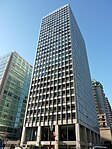Ritz-Carlton Montreal

The Ritz-Carlton Montreal is a luxury hotel located at 1228 Sherbrooke Street West, on the corner of Drummond Street, in Montreal, Quebec. Opened in 1912, it was the first hotel in North America to bear the Ritz-Carlton name. Its name was originally licensed by César Ritz directly, and while the hotel is now part of the chain managed by the Ritz-Carlton Hotel Company it uniquely retains its original branding stylisation. The original builders called themselves the Carlton Hotel Company of Montreal, with the concept of naming it after London's celebrated Carlton Hotel. However, one of the investors, Charles Hosmer, was a personal friend of César Ritz and persuaded his colleagues to incorporate the Ritz name, owing to the success of the Hôtel Ritz Paris that opened in 1898. For a fee of $25,000, César Ritz agreed to lend his name, but stipulated that in accordance with the "Ritz standards", every room was to have its own bathroom; there was to be a kitchen on every floor so room-service meals could be served course by course; and a round-the-clock valet and concierge service was to be made available to the guests for, amongst other duties, tracking lost luggage or ordering theatre tickets etc. Finally, the lobby was to be small and intimate yet with a curved grand staircase for the ladies to show off their ball gowns on their descent.
Excerpt from the Wikipedia article Ritz-Carlton Montreal (License: CC BY-SA 3.0, Authors, Images).Ritz-Carlton Montreal
Rue Sherbrooke Ouest, Montreal Ville-Marie
Geographical coordinates (GPS) Address Nearby Places Show on map
Geographical coordinates (GPS)
| Latitude | Longitude |
|---|---|
| N 45.5 ° | E -73.578 ° |
Address
Ritz Carlton
Rue Sherbrooke Ouest
H3G 2X1 Montreal, Ville-Marie
Quebec, Canada
Open on Google Maps






